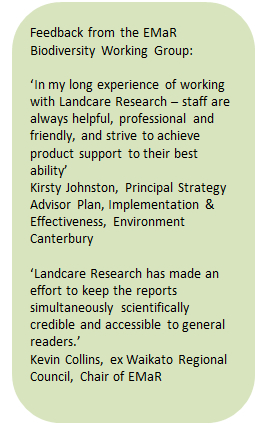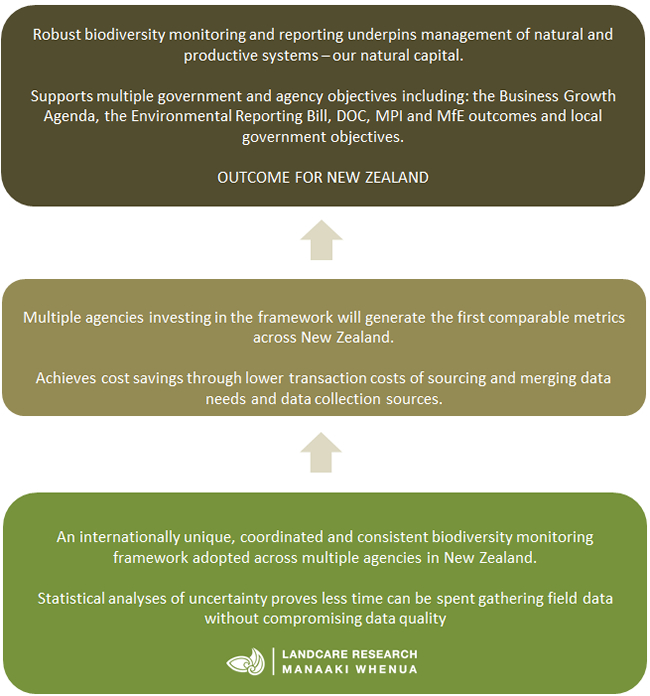Cost-effective biodiversity monitoring

Biodiversity monitoring (Tomas Easdale).
Sarah Richardson
We are known the world over as ‘kiwis’ after the most iconic of our native species. Our distinctive biota and natural landscapes underpin our outdoor recreational lifestyle, the tourism industry and New Zealand’s ‘clean, green, fresh’ reputation in global markets. Yet the reality is that our natural heritage is under increasing pressure from invasive species, land-use intensification and climate change. Millions is spent each year on environmental protection by DOC, regional councils, landowners, groups managing wildlife sanctuaries and communities combined. However different groups of experts have been using different monitoring methods and measuring different things, which means we don’t really know the comparable state of our biodiversity at local, regional and national scales, nor what the most effective monitoring strategies are. This in turn diminishes opportunities to highlight good stewardship of biodiversity as a marketing tool, especially overseas where there is a strong focus on credible biodiversity branding.
Past constraints
Cost-effective monitoring had been limited by:
- a lack of co-ordination between agencies and with the public.
- even within agencies, different components of biodiversity, such as birds and plants, were measured in isolation from one another
- the limited time available to monitor any given site
Nationally-coordinated, consistent and cost-effective monitoring
It was apparent that New Zealand urgently needed to get better value from environmental monitoring expenditure and from the biodiversity data being collected.
The Environmental Monitoring and Reporting (EMaR) project is a Government initiative spanning all agencies with a responsibility for or interest in national environmental reporting data; it includes central and local government and research agencies such as Landcare Research. As such, EMaR has been vital to the development of coordinated and consistent monitoring.
We worked with the various agencies to understand their requirements, then developed an inclusive framework1 that could meet all their needs at the same time. This framework is the culmination of many years of prior research, much of it in partnership with DOC, into appropriate indicators and what constitutes effective monitoring strategies.
This delivered cost savings in a relatively short time. For example, carbon and all biodiversity components can be measured concurrently at the same sampling points, and reduced sampling effort is needed at any given point.
Transparent reporting of uncertainty
A second part of the project focused on a statistically robust understanding of error, bias or uncertainty in the data gathered. Quantifying uncertainty means valid changes in pests or biodiversity can be detected sooner, enabling more timely management responses, and ensuring appropriate resources are used in monitoring. For example, our analyses showed conclusively that DOC could halve its Tier 12 possum monitoring effort. One night’s monitoring (rather than two nights) across a network of plots produced the same quality of data, but at much reduced cost.
More efficient and cost-effective ways to achieve results without sacrificing data quality is a significant key to fast-tracking conservation outcomes.
Transparent reporting of uncertainty also enables the international community to judge whether differences in mean values over time are statistically significant or not. Demonstrating statistical rigour and fit-for-purpose reporting helps reinforce New Zealand’s global reputation for transparency.
 Uptake and application
Uptake and application
The combined framework is unique internationally. It maximises efficiency and interpretative power, minimises the transaction costs of sourcing and merging data sources, and greatly reduces the burden of monitoring for individual agencies.
Our indicator framework and analysis tools have been adopted widely by central and regional government (MfE, DOC, MPI, EMaR and regional councils) and the New Zealand’s Biological Heritage Challenge. Co-ordinated monitoring using similar methods and compatible indicator frameworks are now in place across these agencies.
Our biodiversity uncertainty framework has been adopted by DOC for Tier 1 monitoring. MfE have also adopted it for International Carbon Accounting, and in future, will also use it in national State of the Environment reporting.
Evidence base for environmental stewardship and the New Zealand brand
The Business Growth Agenda includes a ‘Building Natural Resources’ work stream that aims to make ‘better use of New Zealand’s abundant natural resource so we can continue to grow our economy and look after our environment’. Economic growth must be viewed within the context of credible environmental stewardship. Robust environmental monitoring and reporting will provide the evidence underpinning the credibility of the ‘New Zealand brand’ in overseas markets.
Key research collaborators
- Department of Conservation (DOC)
- Ministry for the Environment (MfE)
- Regional councils (via the EMaR Biodiversity Working Group)

1 https://www.mfe.govt.nz/climate-change/tracking-greenhouse-gas-emissions/measuring-forest-carbon
2 Tier 1 Monitoring is broad scale monitoring in the national context: http://www.doc.govt.nz/about-us/our-role/managing-conservation/natural-heritage-management/a-national-system-to-monitor-and-report-on-biodiversity/
